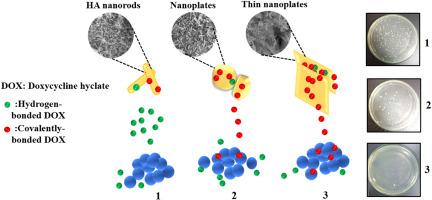天然仿骨羟基磷灰石纳米板作为新型抗生素药物载体:与纳米棒的比较研究
IF 4.9
3区 医学
Q1 PHARMACOLOGY & PHARMACY
Journal of Drug Delivery Science and Technology
Pub Date : 2025-09-02
DOI:10.1016/j.jddst.2025.107474
引用次数: 0
摘要
开发一种具有生物相容性和控释的药物载体对于在感染部位安全、持续地给药以确保完全根除细菌而不产生全身毒性至关重要。羟基磷灰石(HA)纳米晶体(NCs)作为纳米板(NPTs)天然存在于活骨中,具有优异的生物相容性和有效的药物结合位点。然而,关于抗生素在HA npt中的装载及其释放行为以控制细菌生长的研究仍然很少。因此,本研究的重点是水合多西环素(DOX)负载的HA NPTs和薄NPTs (TNPTs)的抗菌作用,并详细分析了它们的载药效率和释放谱,与HA纳米棒(nr)相比。以聚乙烯醇(PVA)为控形剂,水热法制备了HA NCs,包括NRs、NPTs和TNPTs。通过傅里叶变换红外光谱(FTIR)、x射线衍射(XRD)和电子显微镜,确定HA nmr、NPTs和TNPTs的DOX负载效率分别为45.5%、62.2%和73.3%。在测试的HA形态中,HA TNPTs表现出最持久的DOX释放特征,其次是HA NPTs和NRs。羟基磷灰石的表面积及其与DOX相互作用的性质解释了DOX负载和释放速率的差异。体外细胞培养研究表明,所有DOX-HA NCs都能有效促进细胞粘附、增殖和良好的血液相容性。此外,采用定量(MTT法)和定性(活死菌和菌落计数)实验检测DOX-HA NCs对金黄色葡萄球菌的抗菌活性。研究发现,与游离DOX不同,从HA TNPTs中释放的DOX在200 μg/ml时几乎完全抑制了细菌对类似细菌的生长,突出了它们作为细菌根除的有效抗生素载体的潜力。本文章由计算机程序翻译,如有差异,请以英文原文为准。

Natural bone-mimicking hydroxyapatite nanoplates as a novel antibiotic drug vehicle: A comparative study with nanorods
Developing a biocompatible drug vehicle with controlled release is vital for safe and sustained antibiotic delivery at infection site to ensure complete bacterial eradication without systemic toxicity. Hydroxyapatite (HA) nanocrystals (NCs), naturally found in living bone as nanoplates (NPTs), offer exceptional biocompatibility and efficient drug binding sites. However, research on antibiotic loading in HA NPTs and their release behavior for controlling bacterial growth is still scarce. Therefore, the present study focuses on antibacterial effect of doxycycline hyclate (DOX)-loaded HA NPTs and thin NPTs (TNPTs) with detailed analyses of their drug loading efficiency and release profile, compared to HA nanorods (NRs). HA NCs, including NRs, NPTs, and TNPTs were synthesized using polyvinyl alcohol (PVA) as a shape-controlling agent via hydrothermal method. The DOX loading efficiencies of HA NRs, NPTs, and TNPTs were determined to be 45.5, 62.2, and 73.3 %, respectively, confirmed using Fourier transform infrared (FTIR) spectroscopy, X-ray diffraction (XRD), and electron microscopies. Among the tested HA morphologies, HA TNPTs exhibited the most sustained DOX release profile, followed by HA NPTs and NRs. The differential DOX loading and release rate was explained through surface area of HA and their nature of interaction with DOX. In vitro cell culture studies demonstrated that all DOX-HA NCs effectively promoted cell adhesion, proliferation, and good hemocompatibility. Further, the antibacterial activity of DOX-HA NCs was examined using both, quantitative (MTT assay) and qualitative (Live-dead and colony-counting) experiments against S. aureus bacteria. It is found that unlike free DOX, the prolonged DOX release from HA TNPTs leads to nearly complete inhibition of bacterial growth at 200 μg/ml against the similar bacteria, highlighting their potential as an effective antibiotic vehicle for bacterial eradication.
求助全文
通过发布文献求助,成功后即可免费获取论文全文。
去求助
来源期刊
CiteScore
8.00
自引率
8.00%
发文量
879
审稿时长
94 days
期刊介绍:
The Journal of Drug Delivery Science and Technology is an international journal devoted to drug delivery and pharmaceutical technology. The journal covers all innovative aspects of all pharmaceutical dosage forms and the most advanced research on controlled release, bioavailability and drug absorption, nanomedicines, gene delivery, tissue engineering, etc. Hot topics, related to manufacturing processes and quality control, are also welcomed.

 求助内容:
求助内容: 应助结果提醒方式:
应助结果提醒方式:


